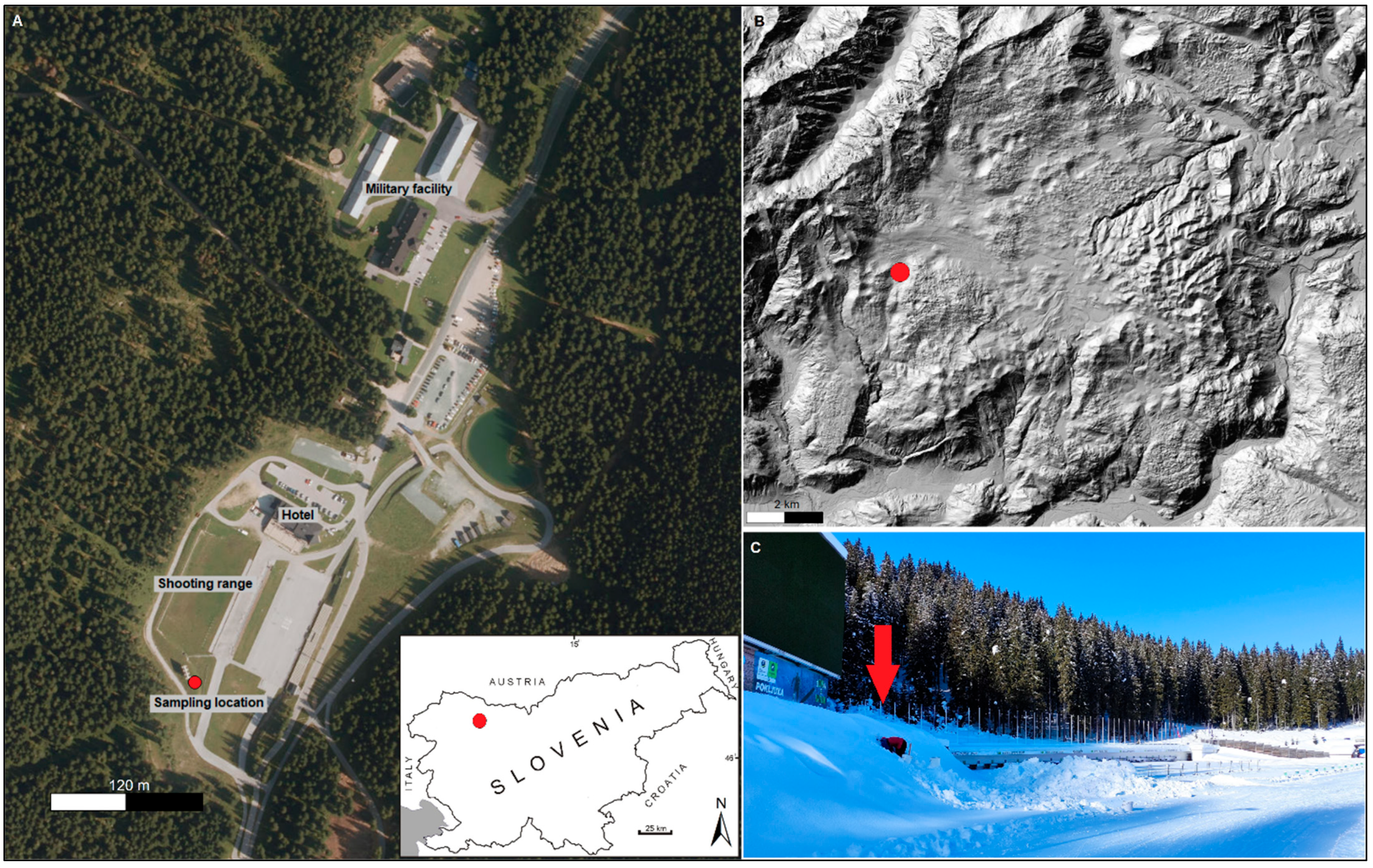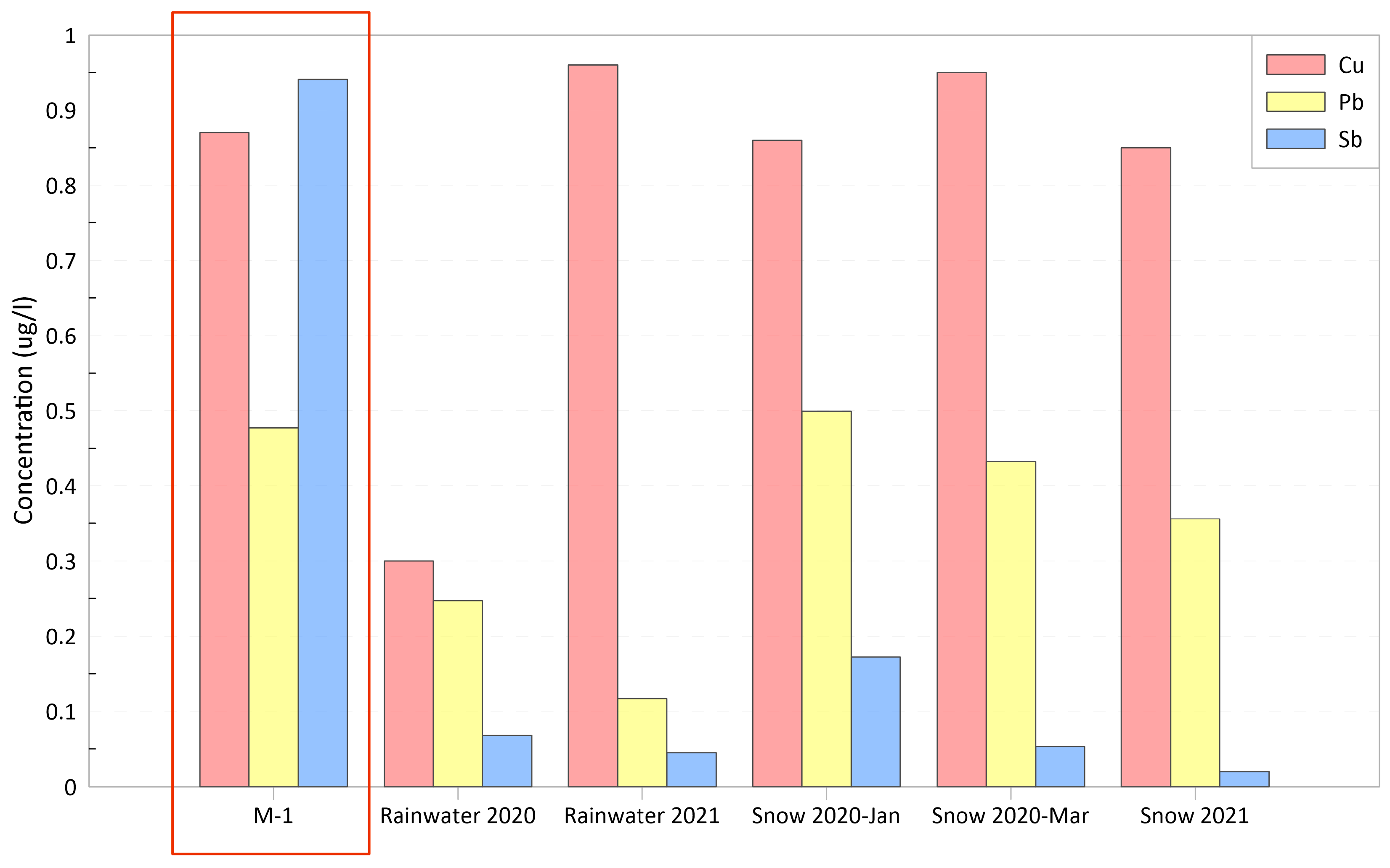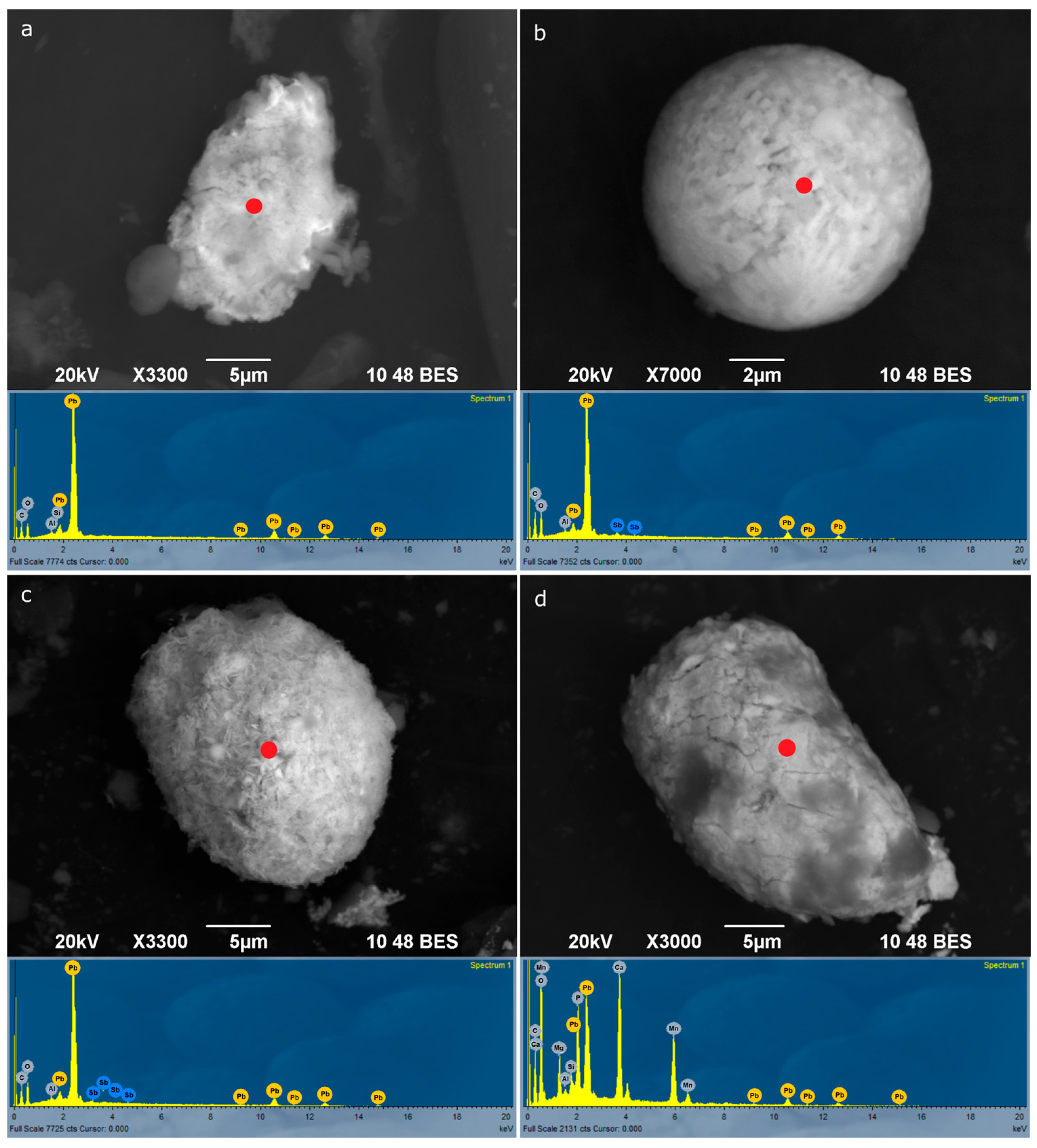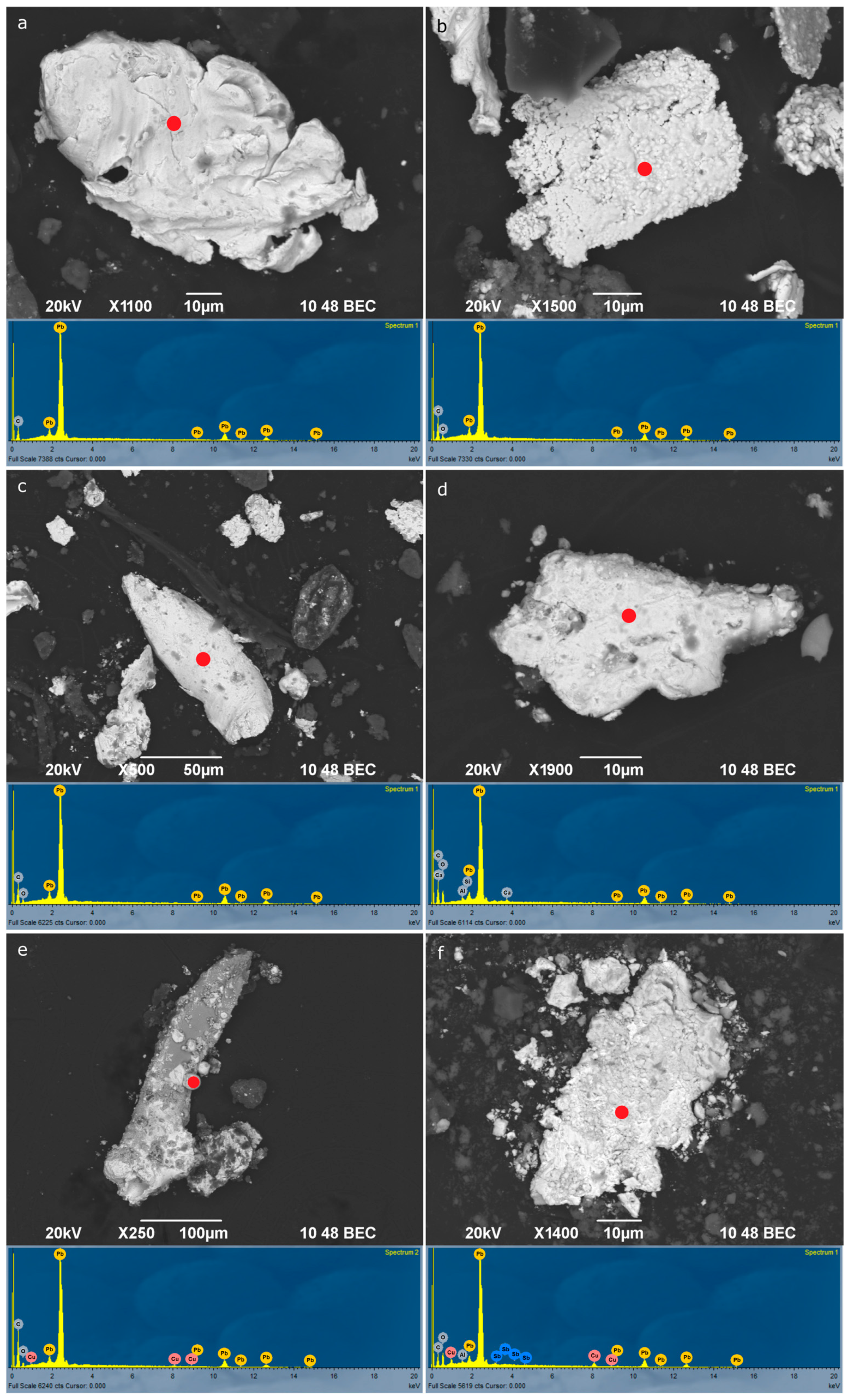Shooting Activities as the Potential Influence on the Environment at the Pokljuka Biathlon Center, Slovenia
Abstract
1. Introduction
2. Materials and Methods
3. Results and Discussion
3.1. Physico-Chemical Parameters and Chemical Compositions of Snowmelt Water
3.2. Characterization of Lead-Bearing Particles in the Snow
3.3. Characterization of Lead-Bearing Particles in the Ammunition
4. Conclusions
Author Contributions
Funding
Institutional Review Board Statement
Informed Consent Statement
Data Availability Statement
Acknowledgments
Conflicts of Interest
References
- U.S. Geological Survey. Mineral Industry Surveys: Lead in January. 2013. Available online: http://minerals.usgs.gov/minerals/pubs/commodity/lead/mis-201301-lead.pdf (accessed on 14 March 2024).
- Randich, E.; Duerfeldt, W.; McLendon, W.; Tobin, W. A metallurgical review of the interpretation of bullet lead compositional analysis. Forensic Sci. Int. 2002, 127, 174–191. [Google Scholar] [CrossRef]
- Barker, A.J.; Mayhew, L.E.; Douglas, T.A.; Ilgen, A.G.; Trainor, T.P. Lead and antimony speciation associated with the weathering of bullets in a historic shooting range in Alaska. Chem. Geol. 2020, 553, 119797. [Google Scholar] [CrossRef]
- Rooney, C.P.; McLaren, R.G.; Cresswell, R.J. Distribution and phytoavailability of lead in a soil contaminated with lead shot. Water Air Soil Pollut. 1999, 116, 535–548. [Google Scholar] [CrossRef]
- Rooney, C.P.; McLaren, R.G.; Condron, L.M. Control of lead solubility in soil contaminated with lead shot: Effect of soil pH. Environ. Pollut. 2007, 149, 149–157. [Google Scholar] [CrossRef]
- Mitsunobu, S.; Takahashi, Y.; Terada, Y.; Sakata, M. Antimony (V) Incorporation into synthetic ferrihydrite, goethite, and natural iron oxyhydroxides. Environ. Sci. Technol. 2010, 44, 3712–3718. [Google Scholar] [CrossRef]
- Duggan, J.; Dhawan, A. Speciation and vertical distribution of lead and lead shot in soil at a recreational firing range. Soil Sediment Contam. 2007, 16, 351. [Google Scholar] [CrossRef]
- Evangelou, M.W.; Hockmann, K.; Pokharel, R.; Jakob, A.; Schulin, R. Accumulation of Sb, Pb, Cu, Zn and Cd by various plants species on two different relocated military shooting range soils. J. Environ. Manag. 2012, 108, 102–107. [Google Scholar] [CrossRef] [PubMed]
- Busby, R.R.; Douglas, T.A.; LeMonte, J.J.; Ringelberg, D.B.; Indest, K.J. Metal accumulation capacity in indigenous Alaska vegetation growing on military training lands. Int. J. Phytoremediation 2019, 22, 259–266. [Google Scholar] [CrossRef]
- Barker, A.J.; Clausen, J.L.; Douglas, T.A.; Bednar, A.J.; Griggs, C.S.; Martin, W.A. Environmental impact of metals resulting from military training activities: A review. Chemosphere 2020, 265, 129110. [Google Scholar] [CrossRef]
- Urrutia-Goyes, R.; Mahlknecht, J.; Argyaki, A.; Ornelas-Soto, N. Trace element soil contamination at a former shooting range in Athens, Greece. Geoderma Reg. 2017, 10, 191–199. [Google Scholar] [CrossRef]
- Rodríguez-Seijo, A.; Vega, F.A.; Arenas-Lago, D. Assessment of iron-based and calcium-phosphate nanomaterials for immobilisation of potentially toxic elements in soils from a shooting range berm. J. Environ. Manag. 2020, 267, 110640. [Google Scholar] [CrossRef]
- Vingiani, S.; Buttafuoco, G.; Fagnano, M.; Guarino, A.; Perreca, C.; Albanese, S. A multisensor approach coupled with multivariate statistics and geostatistics for assessing the status of land degradation: The case of soils contaminated in a former outdoor shooting range. Sci. Total Environ. 2024, 933, 172398. [Google Scholar] [CrossRef]
- Apostoli, P.; Cornelis, R.; Duffus, J. Elemental Speciation in Human Health Risk Assessment; Environmental Health Criteria: Geneva, Switzerland, 2006; Volume 234, pp. 1–256. [Google Scholar]
- Mason, L.H.; Harp, J.P.; Han, D.Y. Pb Neurotoxicity: Neuropsychological effects of lead toxicity. BioMed Res. Int. 2014, 8, 840547. [Google Scholar] [CrossRef]
- Fuchs, B.; Thiel, A.; Zedrosser, A.; Brown, L.; Hydeskov, H.B.; Rodushkin, I.; Evans, A.L.; Boesen, A.H.; Græsli, A.R.; Kindberg, J.; et al. High Concentrations of lead (Pb) in Blood and Milk of Free-Ranging Brown Bears (Ursus arctos) in Scandinavia. Environ. Pollut. 2021, 287, 117595. [Google Scholar] [CrossRef] [PubMed]
- Helander, B.; Krone, O.; Räikkönen, J.; Sundbom, M.; Ågren, E.; Bignert, A. Major lead exposure from hunting ammunition in eagles from Sweden. Sci. Total Environ. 2021, 795, 148799. [Google Scholar] [CrossRef]
- Chiverton, L.; Cromie, R.; Kock, R. European mammal exposure to lead from ammunition and fishing weight sources. Heliyon 2022, 8, e10014. [Google Scholar] [CrossRef] [PubMed]
- Kim, K.H.; Kang, C.H.; Lee, J.H.; Choi, K.C.; Youn, Y.H.; Hong, S.M. Investigation of airborne lead concentrations in relation to Asian Dust events and air mass transport pathways. J. Aerosol Sci. 2006, 37, 1809–1825. [Google Scholar] [CrossRef]
- Lee, H.J.; Lee, H.-Y. Characterization of lung function impairment and pathological changes induced by chronic lead and cadmium inhalation: Insights from a mouse model study. Ecotoxicol. Environ. Saf. 2024, 283, 116776. [Google Scholar] [CrossRef]
- Mozafar, A.; Ruh, R.; Klingel, P.; Gamper, H.; Egli, S.; Frossard, E. Effect of heavy metal contaminated shooting range soils on mycorrhizal colonization of roots and metal uptake by leek. Environ. Monit. Assess. 2002, 79, 177–191. [Google Scholar] [CrossRef] [PubMed]
- Robinson, B.H.; Bischofberger, S.; Stoll, A.; Schroer, D.; Gurrer, G.; Roulier, S.; Gruenwald, A.; Attinger, W.; Schulin, R. Plant uptake of trace elements on a Swiss military shooting range: Uptake pathways and land management implications. Environ. Pollut. 2008, 153, 669–676. [Google Scholar] [CrossRef]
- Ghouri, F.; Shahid, M.J.; Zhong, M.; Zia, M.A.; Alomrani, S.O.; Liu, J.; Sun, L.; Ali, S.; Liu, X.; Shahid, M.Q. Alleviated lead toxicity in rice plant by co-augmented action of genome doubling and TiO2 nanoparticles on gene expression, cytological and physiological changes. Sci. Total Environ. 2024, 911, 168709. [Google Scholar] [CrossRef]
- Pal, P.; Pramanik, K.; Ghosh, S.K.; Mondal, S.; Mondal, T.; Soren, T.; Maiti, T.K. Molecular and eco-physiological responses of soil-borne lead (Pb2+)-resistant bacteria for bioremediation and plant growth promotion under lead stress. Microbiol. Res. 2024, 287, 127831. [Google Scholar] [CrossRef] [PubMed]
- Gosar, M.; Šajn, R.; Bavec Špela Gaberšek, M.; Pezdir, V.; Miler, M. Geochemical background and threshold for 47 chemical elements in Slovenian topsoil. Geologija 2019, 62, 7–59. [Google Scholar] [CrossRef]
- Reimann, C.; Fabian, K.; Birke, M.; Filzmoser, P.; Demetriades, A.; Négrel, P.; Oorts, K.; Matschullat, J.; de Caritat, P.; GEMAS Project Team. GEMAS: Establishing geochemical background and threshold for 53 chemical elements in European agricultural soil. Appl. Geochem. 2018, 88, 302–318. [Google Scholar] [CrossRef]
- Šajn, R. Factor Analysis of Soil and Attic-dust to Separate Mining and Metallurgy Influence, Meza Valley, Slovenia. Math. Geol. 2006, 38, 735–747. [Google Scholar] [CrossRef]
- Gosar, M.; Bavec Špela Miler, M.; Gaberšek, M. Contents of potentially toxic elements in sediments and waters of the Meža river and its tributaries draining mine waste deposits. Geologija 2024, 67, 41–61. [Google Scholar] [CrossRef]
- Miler, M.; Gosar, M. Characteristics and potential environmental influences of mine waste in the area of the closed Mežica Pb–Zn mine (Slovenia). J. Geochem. Explor. 2012, 112, 152–160. [Google Scholar] [CrossRef]
- Žibert, G.; Gosar, M.; Miler, M.; Alijagić, J. Impacts of mining and smelting activities on environment and landscape degradation—Slovenian case studies. Land Degrad. Dev. 2018, 29, 4457–4470. [Google Scholar] [CrossRef]
- Miler, M.; Bavec, Š.; Gosar, M. The environmental impact of historical Pb-Zn mining waste deposits in Slovenia. J. Environ. Manag. 2022, 308, 114580. [Google Scholar] [CrossRef]
- Šajn, R.; Gosar, M. Onesnaženost tal v okolici Litije kot posledica rudarskih in metalurških dejavnosti ter naravnih danosti. Geologija 2007, 50, 131–145. [Google Scholar] [CrossRef]
- Šajn, R.; Gosar, M. Multivariate statistical approach to identify metal sources in Litija area (Slovenia). J. Geochem. Explor. 2014, 138, 8–21. [Google Scholar] [CrossRef]
- Gaberšek, M.; Gosar, M. Geochemistry of urban soil in the industrial town of Maribor, Slovenia. J. Geochem. Explor. 2018, 187, 141–154. [Google Scholar] [CrossRef]
- Gaberšek, M.; Grčman, H.; Gosar, M. Mineral composition, pedological characteristics and fractionation of selected chemical elements in soil of Maribor. Geologija 2020, 63, 177–191. [Google Scholar] [CrossRef]
- Gaberšek, M.; Gosar, M. Meltwater chemistry and characteristics of particulate matter deposited in snow as indicators of anthropogenic influences in an urban area. Environ. Geochem. Health 2021, 43, 2583–2595. [Google Scholar] [CrossRef]
- Gaberšek, M.; Gosar, M. Towards a holistic approach to the geochemistry of solid inorganic particles in the urban environment. Sci. Total Environ. 2021, 763, 144214. [Google Scholar] [CrossRef] [PubMed]
- Cordeiro, L.M.; Soares, M.V.; da Silva, A.F.; dos Santos, L.V.; de Souza, L.I.; da Silveira, T.L.; Baptista, F.B.O.; de Oliveira, G.V.; Pappis, C.; Dressler, V.L.; et al. Toxicity of copper and zinc alone and in combination in Caenorhabditis elegans model of Huntington’s disease and protective effects of rutin. Neurotoxicology 2023, 97, 120–132. [Google Scholar] [CrossRef] [PubMed]
- Ansari, A.A.; Gill, S.S.; Gill, R.; Lanza, G.R.; Newman, L. Phytoremediation: Management of Environmental Contaminants; Springer: New York, NY, USA, 2016; Volume 3, p. 3. [Google Scholar]
- Filella, M.; Belzile, N.; Chen, Y.W. Antimony in the environment: A review focused on natural waters I. Occurrence. Earth Sci. Rev. 2002, 57, 125–176. [Google Scholar] [CrossRef]
- WHO, World Health Organization. Antimony in Drinking Water; Background Document for Development of WHO Guidelines for Drinking Water Quality; World Health Organization: Geneva, Switzerland, 2003. [Google Scholar]
- Boreiko, C.J.; Rossman, T.G. Antimony and its compounds: Health impacts related to pulmonary toxicity, cancer, and genotoxicity. Toxicol. Appl. Pharmacol. 2020, 403, 115156. [Google Scholar] [CrossRef]
- Vidya, C.S.-N.; Shetty, R.; Vaculíková, M.; Vaculík, M. Antimony toxicity in soils and plants, and mechanisms of its alleviation. Environ. Exp. Bot. 2022, 202, 104996. [Google Scholar] [CrossRef]
- Chen, Q.Y.; Zhu, Y.M.; Zhang, J.J.; Tong, Y.R.; Liu, H.; Rensing, C.; Feng, R.W. Toxicity of antimony to plants: Effects on metabolism of N and S in a rice plant. Plant Physiol. Biochem. 2024, 216, 109069. [Google Scholar] [CrossRef]
- LiDAR (Public Information of Slovenia, the Surveying and Mapping Authority of the Republic of Slovenia, LiDAR, 2015) ARSO, Ministry of the Environment. Available online: http://gis.arso.gov.si/evode/profile.aspx?id=atlas_voda_Lidar@Arso (accessed on 12 November 2024).
- Pezdir, V.; Gaberšek, M.; Gosar, M. Characterization of Atmospheric Deposition as the Only Mineral Matter Input to Ombrotrophic Bog. Minerals 2022, 12, 982. [Google Scholar] [CrossRef]
- Compton, R.R. Manual of Field Geology; JohnWiley & Sons: New York, NY, USA, 1962; 378p. [Google Scholar]
- Pezdir, V.; Serianz, L.; Gosar, M. Evaluating Mineral Matter Dynamics within the Peatland as Reflected in Water Composition. Sustainability 2024, 16, 4857. [Google Scholar] [CrossRef]
- Frohne, T.; Rinklebe, J.; Dia-Bone, R.; Du Laing, G. Controlled variation of redox conditions in a floodplain soil: Impact on metal mobilization and biomethylation of arsenic and antimony. Geoderma 2011, 160, 414–424. [Google Scholar] [CrossRef]
- Goričan, Š.; Žibret, L.; Košir, A.; Kukoč, D.; Horvat, A. Stratigraphic correlation and structural position of Lower Cretaceous flysch-type deposits in the eastern Southern Alps (NW Slovenia). Int. J. Earth Sci. 2018, 107, 2933–2953. [Google Scholar] [CrossRef]
- Jurkovšek, B. Osnovna geološka karta 1:100,000, Tolmač listov Beljak in Ponteba, L 33-51, L 33-52; Geološki zavod Ljubljana, Zvezni geološki zavod: Belgrade, Serbia, 1987. [Google Scholar]
- Vidrih, R.; Herlec, U. Nahajališča bobovca v predgorju Julijskih Alp. Scopolia. Suppl. 2006, 3, 154–157. [Google Scholar]





| Code | Date and Location | pH | EC (μS/cm) | Volume (l) |
|---|---|---|---|---|
| M-1 | 24th February 2021 (snow profile) | 5.6 | 3.2 | 3.7 |
| M-2 | 25th January 2023 (compact layer) | 5.7 | 3.1 | 3.6 |
| M-3 | 25th January 2023 (boundary) | 5.4 | 2.0 | 4.3 |
| M-4 | 25th January 2023 (snow profile) | 5.7 | 3.0 | 3.6 |
| Code | Quartz and Silica Minerals (%) | Aluminosilicates (%) | Carbonates (%) | Organic Particles (%) | Iron Oxyhydroxides (%) | Lead Oxides (%) |
|---|---|---|---|---|---|---|
| M-1 | 30 | 25 | 17 | 13 | 9 | 6 |
| M-2 | 35 | 25 | 12 | 14 | 8 | 6 |
| M-3 | 35 | 24 | 14 | 12 | 8 | 7 |
| M-4 | 28 | 23 | 20 | 12 | 10 | 7 |
Disclaimer/Publisher’s Note: The statements, opinions and data contained in all publications are solely those of the individual author(s) and contributor(s) and not of MDPI and/or the editor(s). MDPI and/or the editor(s) disclaim responsibility for any injury to people or property resulting from any ideas, methods, instructions or products referred to in the content. |
© 2025 by the authors. Licensee MDPI, Basel, Switzerland. This article is an open access article distributed under the terms and conditions of the Creative Commons Attribution (CC BY) license (https://creativecommons.org/licenses/by/4.0/).
Share and Cite
Pezdir, V.; Gosar, M. Shooting Activities as the Potential Influence on the Environment at the Pokljuka Biathlon Center, Slovenia. Atmosphere 2025, 16, 915. https://doi.org/10.3390/atmos16080915
Pezdir V, Gosar M. Shooting Activities as the Potential Influence on the Environment at the Pokljuka Biathlon Center, Slovenia. Atmosphere. 2025; 16(8):915. https://doi.org/10.3390/atmos16080915
Chicago/Turabian StylePezdir, Valentina, and Mateja Gosar. 2025. "Shooting Activities as the Potential Influence on the Environment at the Pokljuka Biathlon Center, Slovenia" Atmosphere 16, no. 8: 915. https://doi.org/10.3390/atmos16080915
APA StylePezdir, V., & Gosar, M. (2025). Shooting Activities as the Potential Influence on the Environment at the Pokljuka Biathlon Center, Slovenia. Atmosphere, 16(8), 915. https://doi.org/10.3390/atmos16080915







